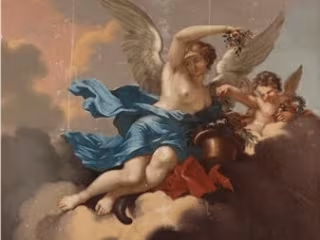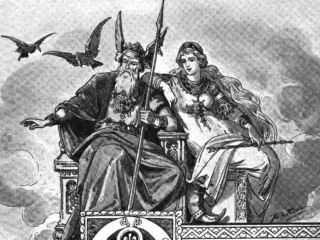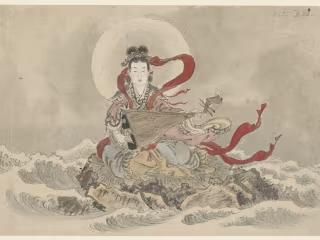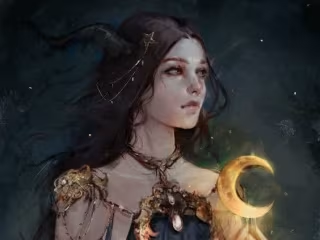Sita: The Goddess of Courage and Purity
0
Ghostwriter
Blog Writer
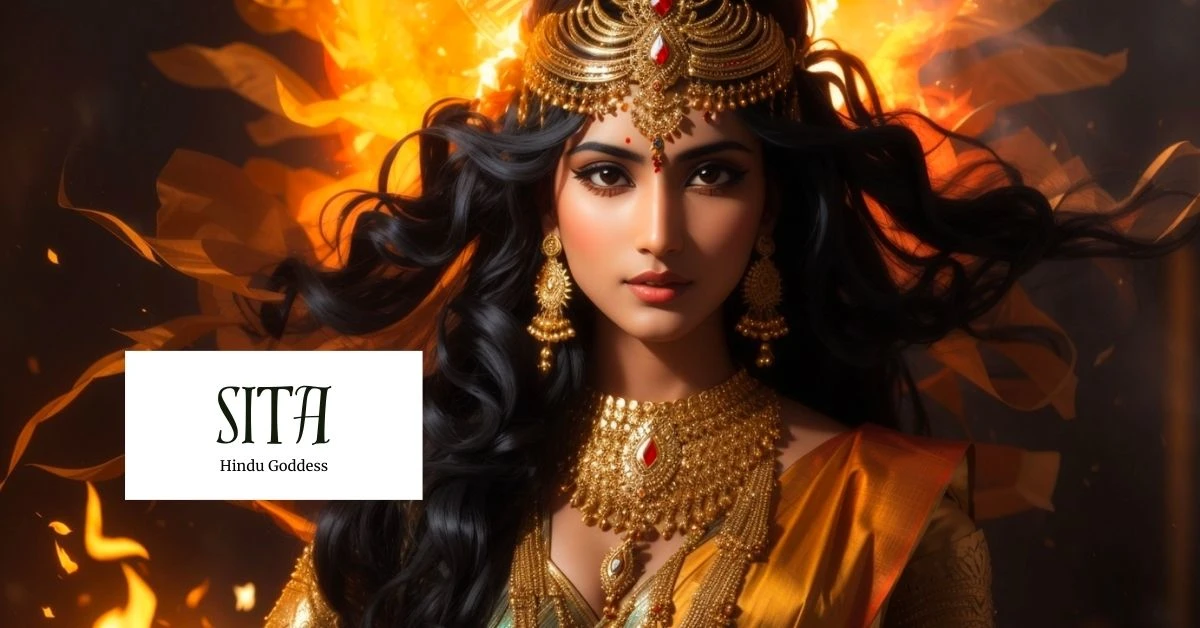
Sita, the Goddess of Courage and Purity, is a revered and iconic figure in Hindu mythology and the ancient epic Ramayana. Widely known for her unwavering loyalty and virtue, she is admired by millions across generations. Her story has been passed down through various means, including oral tradition, sacred texts, and cultural expressions, and her divine connection with Lord Rama is especially significant as it represents the eternal values of love, sacrifice, and unwavering faith. As a result, Sita’s legacy has endured through the ages, inspiring countless individuals to embody her honorable qualities and strive towards a life of devotion and purity.
Overview of Sita
Sita has many names, including Vaidehi and Janaki. The goddess holds a significant place in the revered Hindu scripture Ramayana, which depicts the heroic deeds of her husband, Lord Rama, and their divine love story.
Embodying womanly elegance and wifely virtue, Sita’s devotion to Lord Rama transcends all boundaries, and she is considered an esteemed example of a devoted wife in Hindu culture. In fact, many believe she is the reincarnated form of Lakshmi, the consort of Lord Vishnu. Choosing to reincarnate herself on Earth to provide humanity with a role model of virtuousness, Sita’s story continues to inspire millions of people worldwide (“Sita – New World Encyclopedia”).
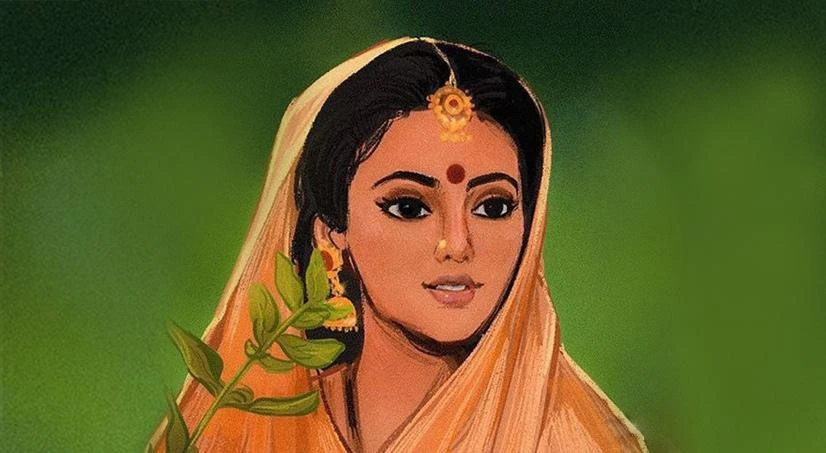
Source: instaastro
Titles
Daughter of Mother Earth
Princess of Videha
Wife of Rama
Abilities
Goddess Sita’s divine nature and virtue are deeply rooted in her exceptional abilities. Her unwavering devotion and patience towards Lord Rama are at the forefront of these abilities. Throughout their marriage, Sita’s steadfast love and loyalty toward her husband exemplify her unparalleled patience and dedication amidst trials and tribulations. Additionally, her self-sacrifice is a testament to her profound commitment to righteousness. By choosing to accompany Lord Rama during his fourteen-year exile, she willingly abandoned the comforts of royalty to support her husband, showcasing her unwavering determination and sacrifice. Despite the challenges thrown her way, Sita’s inner strength remains unshaken. Her ability to endure hardships with grace and resilience reflects her deep inner fortitude and unwavering spirit, inspiring all who encounter obstacles in their own lives (“Sita – Hindu Goddess of Courage and Purity”).
The extraordinary abilities of Goddess Sita transcend her role as a mythical figure, providing devotees with timeless lessons in devotion, sacrifice, purity, and inner strength. Her story continues to captivate and inspire individuals, serving as a reminder of the boundless power of love and righteousness.
Characteristics
The depiction of Goddess Sita as a paragon of beauty and grace is a testament to her divine origins and celestial nature. Her physical appearance and overall bearing are often described in awe-inspiring terms, with Indian art, sculpture, and iconography portraying her as a radiant woman with pleasing facial features. She is fair-skinned and possesses long, black hair, which may be covered by an elaborate headdress that signifies her royal status. As befits her social status, she is frequently adorned with gold bracelets and anklets, and she wears a sari that symbolizes her chaste and virtuous nature. Her countenance is typically anthropomorphic, though she may be depicted with additional arms in images that seek to emphasize her incarnation as Lakshmi. In religious iconography, she is usually situated on the left-hand side of her husband, Rama, alongside other vital characters from the Ramayana, such as Hanuman, Lakshmana, her twin sons, and occasionally even Ravana. These images often depict significant scenes from the Hindu epic (“Sita – New World Encyclopedia”).
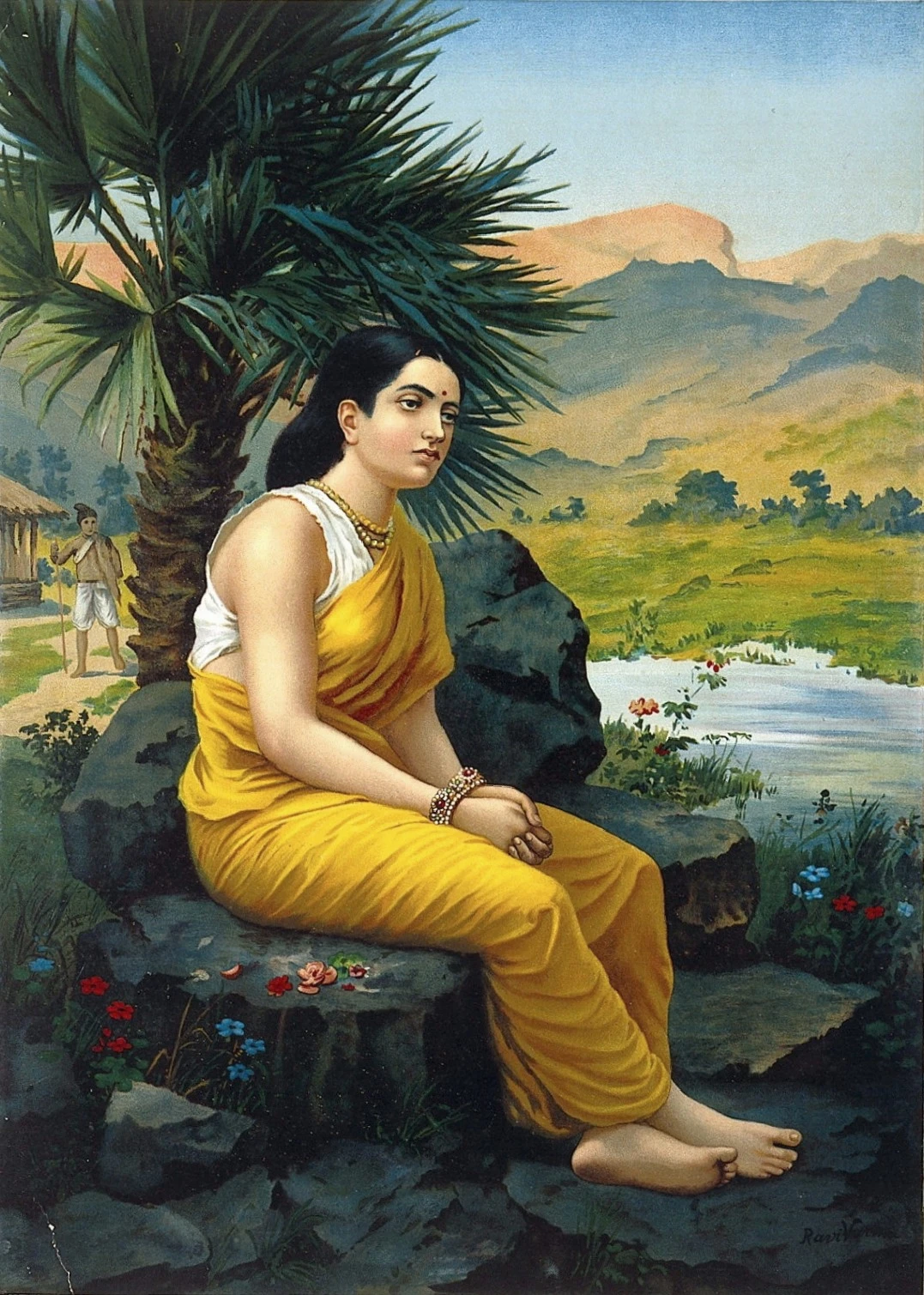
Source: Wikipedia
Traits
An unwavering devotion to Lord Rama defines Sita’s character. Her selfless love and steadfast loyalty to her divine consort are examples of spiritual connection, inspiring devotees to deepen their devotion. Despite facing trials and tribulations, Sita demonstrates remarkable courage and resilience, remaining true to her principles and upholding righteousness.
The goddess’s unwavering strength in the face of adversity is a guiding light for those navigating challenging circumstances, encouraging them to remain steadfast in their moral convictions. Sita embodies divine virtues such as compassion, devotion, and courage, making her a perpetual source of inspiration and a model for humanity. Her timeless traits encourage devotees to cultivate a noble and virtuous character in their own lives, making her an enduring symbol of courage and purity in Hindu mythology (“Sita – Hindu Goddess of Courage and Purity”).
Symbols
Sita, a revered figure in Hindu mythology, embodies the essence of Earth’s fertility, abundance, and well-being. According to Hinduism, she is the daughter of Mother Earth, conceived through the union of a king and the land (Wikipedia Contributors). This association emphasizes her inherent connection to nature and nurturing qualities, positioning her as a compassionate and caring mother figure to all living beings.
The sacred fire, Agni, is inextricably intertwined with Sita’s purity, as her miraculous birth came about through a divine offering made in the holy flames. Agni symbolizes her religious origins and underscores her status as a celestial being born of divine grace and sanctity.
Together, these symbols create a profound tapestry, capturing the essence of Goddess Sita’s character and significance in Hindu mythology. As such, she inspires devotees to seek purity, nurture life, and recognize the divinity within each being.
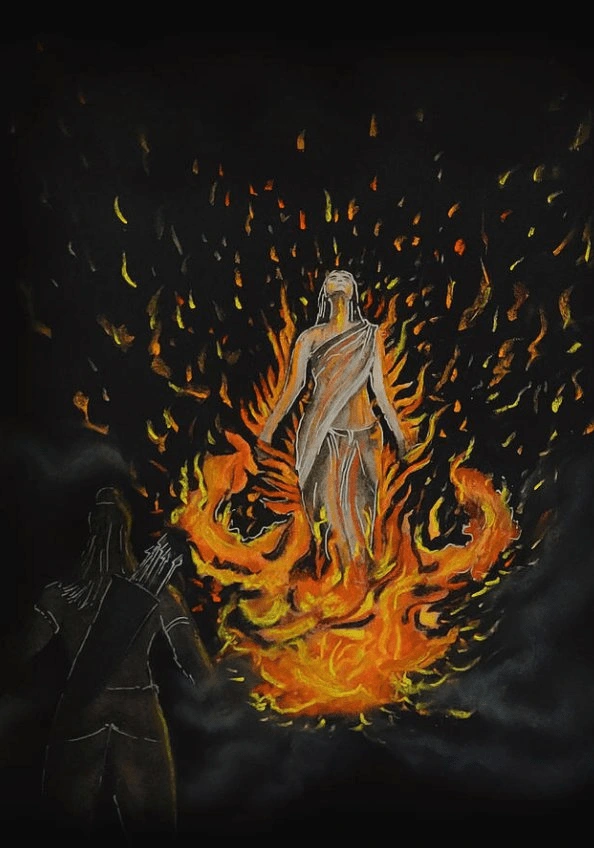
Source: sanatanadhara
Festivals and Rituals
Devotees of the Hindu goddess Sita partake in various festivals and rituals to honor her divine presence and seek her blessings. One such significant festival is Sita Navami, which falls on the ninth day (Navami) of the waxing moon in the Hindu month of Vaishakha. This auspicious occasion commemorates Sita’s birth anniversary and allows devotees to express their reverence and devotion. On this day, devotees observe fasts, visit temples, and recite hymns praising the goddess, seeking her divine grace and blessings (“Sita – Hindu Goddess of Courage and Purity”).
Another important festival is Rama Navami, which marks the wedding anniversary of Lord Rama and Goddess Sita and is celebrated on the final day of a larger nine-day festival called Vasanthotsavam (the “Festival of Spring”). During this festival, worshippers perform marriage celebrations for small statues of Sita and Rama in their homes and take them onto the streets in a grand procession in the evening. Temples are adorned with elaborate decorations, and readings of the Ramayana take place. The occasion serves as a time for spiritual reflection and for Hindus worldwide to direct their prayers to Lord Rama, Goddess Sita, and their close companions (“Sita – New World Encyclopedia”).
These festivals and rituals showcase devotees’ profound devotion and love for Goddess Sita. They reaffirm the timeless tale of the Ramayana and provide an opportunity for seeking divine blessings from the goddess of courage and purity.
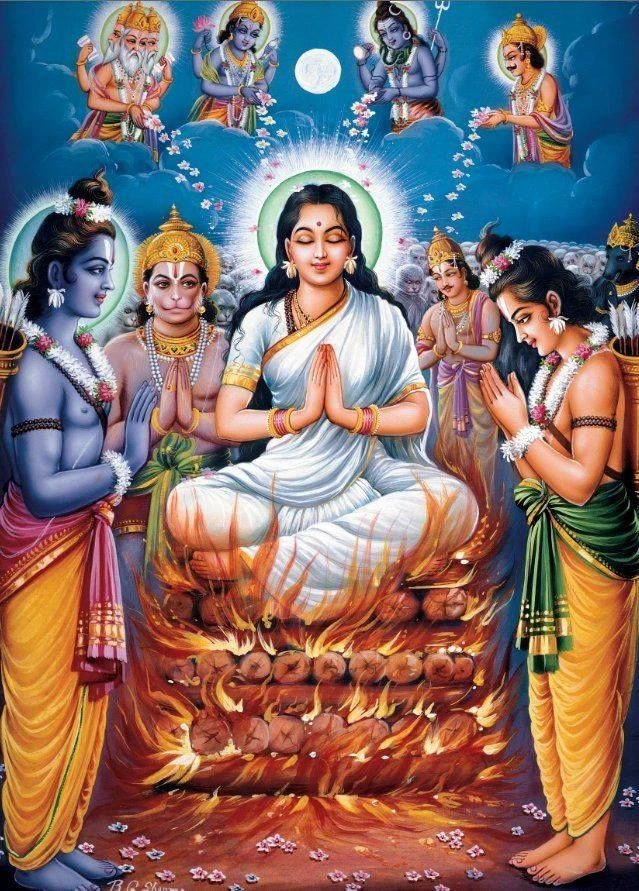
Source: hindupad
Legends associated with Sita
Sita’s story has been interwoven into the tapestry of ancient history. From her fiery entrance into the world to her union with Rama, she has faced exile and kidnapping. Nevertheless, her legacy has persisted through the ages, and her tales have been passed down from generation to generation. She has become an enduring symbol of strength and purity, a testament to the power of a story that stands the test of time. With roots stretching back to antiquity, Sita’s legends inspire and captivate audiences today.
Origin story
The origin story of Goddess Sita is steeped in various iterations, as depicted in many sources. According to the revered Valmiki Ramayana, Sita is deemed the incarnation of Goddess Lakshmi, the consort of Lord Vishnu, who assumed human form to be with him during his seventh avatar as Lord Rama. This divine union between Sita and Rama was not merely for personal love. Instead, it was infused with a grander purpose – eradicating evil and reinstating Dharma (righteousness) on Earth.
The divine birth of Sita is attributed to a sacred ritual where King Janaka of Mithila performed a yajna (sacrificial offering) to seek progeny. During this yajna, Sita emerged from the depths of the sacrificial fire, bearing witness to her divine origins and association with Agni (fire), further emphasizing her celestial nature.
This age-old narrative portrays Goddess Sita as embodying divine love, virtue, and selflessness, tasked with a divine mission to establish righteousness and conquer evil. Her extraordinary birth and divine purpose elevate her status in Hindu mythology, making her an inspiration for millions, even in contemporary times. (“Sita – New World Encyclopedia”).
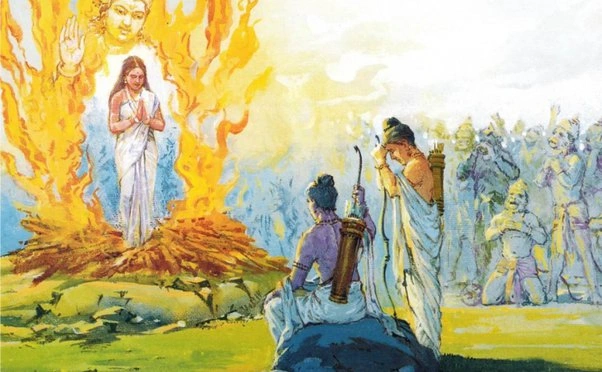
Source: sanatanadhara
Sita’s Swayamvara
One of the most celebrated and enduring legends surrounding Goddess Sita is the tale of her Swayamvara, a customary practice in ancient India where a princess could choose her life partner from a gathering of suitors. The Ramayana narrates a remarkable version of Sita’s Swayamvara, transforming it into a test of strength and bravery.
During the event, a colossal bow, believed to be Lord Shiva’s, was placed before the assembly of suitors. The task was to lift and string the bow, a feat deemed impossible for ordinary mortals due to its immense weight and divine origin. As the princes attempted in vain, their limitations were evident. However, the scene took an extraordinary turn when Lord Rama, accompanied by his loyal brother Lakshmana, approached the bow. With effortless grace and divine prowess, Rama lifted and strung the formidable bow, astonishing everyone present. So strong and adept was Rama in performing the task that he broke the mighty bow in the process. With that, not only was Rama’s vigor evident to King Janaka, but he had also stolen the heart of Sita. So the two were wed (“Sita, Hindu Goddess: Story & Description | Who Is Sita in Ramayana?”).
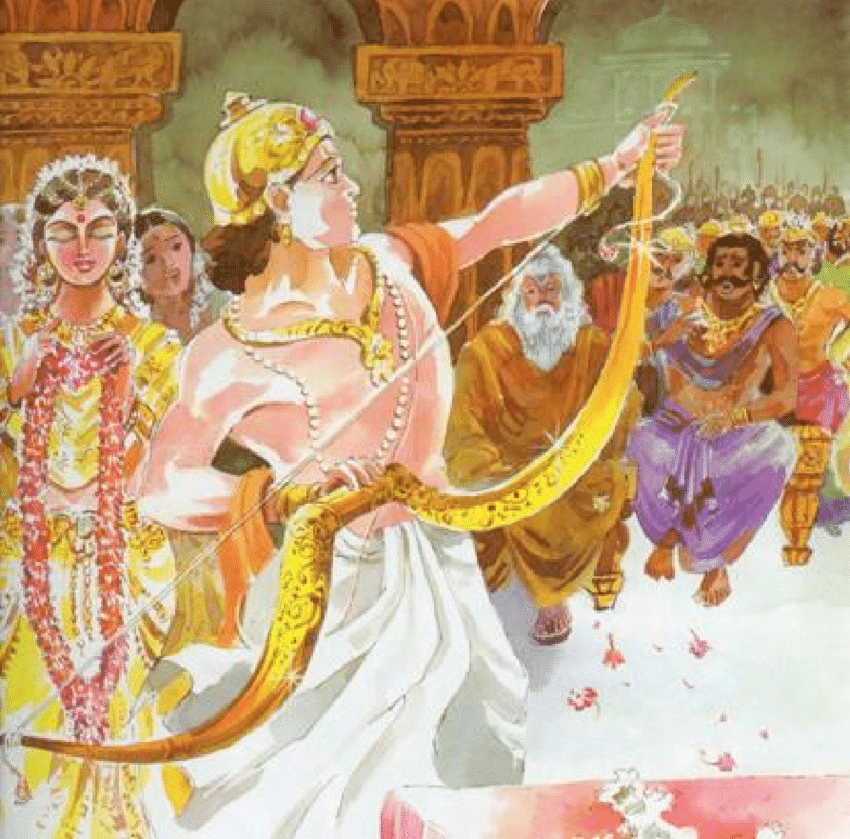
Source: researchgate
Exile and Abduction
Goddess Sita’s life is marked by an essential and moving episode involving her exile and abduction by the demon king, Ravana. Following their wedding, circumstances arose that led Rama to believe it was his duty to spend a period of exile in the forests of Dandakaranya. Sita dutifully accompanied him during his fourteen-year exile, demonstrating her unwavering commitment and loyalty to her husband. Tragedy struck when Ravana, captivated by Sita’s exceptional beauty and virtue, deceitfully posed as a mendicant and forcefully abducted her to his kingdom of Lanka.
Despite the dire circumstances and the emotional turmoil caused by her separation from Rama, Sita remained steadfast in her devotion to her beloved. Throughout her captivity, she demonstrated immense courage, resilience, and unwavering faith in her husband’s eventual rescue (Wikipedia Contributors).
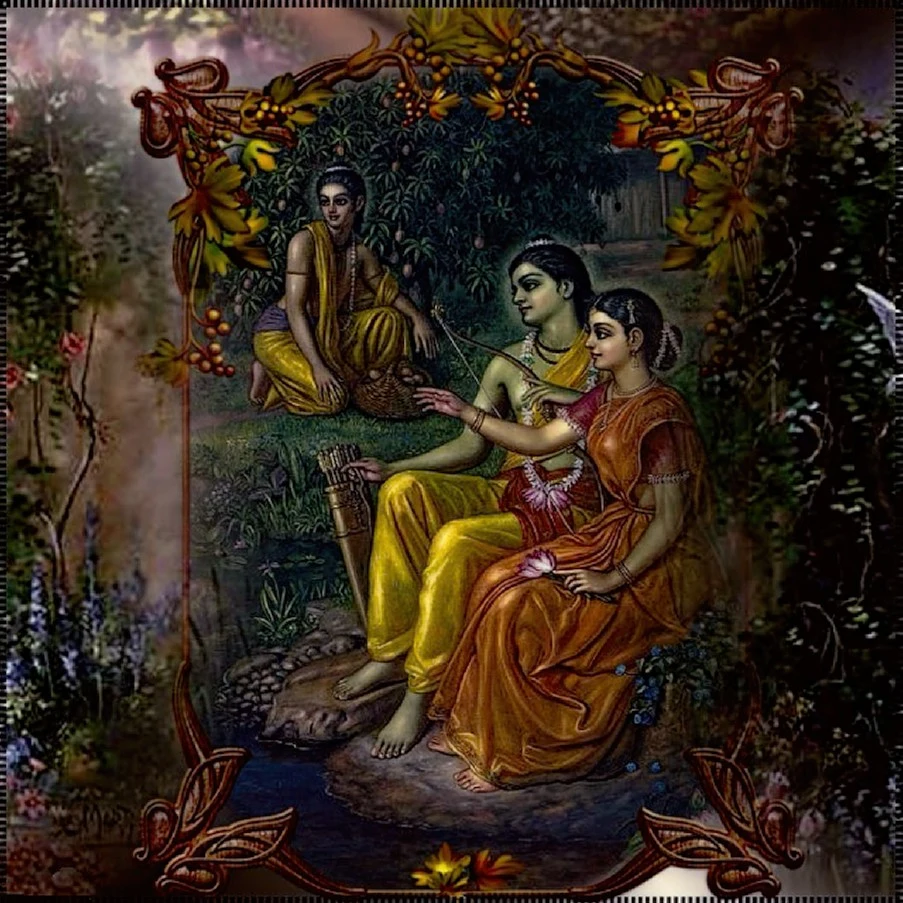
Soource: iskcondesiretree
Influences of other religions/cultures on Sita
Throughout history, the character and representation of Goddess Sita have been shaped by various cultures and religions. One notable influence on her portrayal is Jainism, a religious tradition emphasizing Sita’s status as an enlightened soul. According to Jain texts, Sita embodies non-violence and self-control, serving as a moral role model for humanity and exemplifying Jain’s virtues and ethical values.
The Jain perspective on Sita elevates her spiritual status, presenting her as an enlightened person who transcends cultural and religious boundaries. This view underscores the timeless relevance of Sita’s virtues, which inspire individuals to seek moral and spiritual guidance across different belief systems. The portrayal of Sita in Jainism highlights her embodiment of Jain’s values and ethical principles, emphasizing the importance of leading a virtuous life.
Overall, the Jain influence on Sita’s portrayal adds a unique and valuable perspective to the understanding of this revered goddess. It showcases the universality of Sita’s integrity and expands her significance beyond the confines of Hinduism. The depiction of Sita in Jainism underscores her moral character, making her a source of inspiration for individuals seeking guidance in their pursuit of spiritual and ethical growth (“Sita – Hindu Goddess of Courage and Purity”).
Modern appearances
Throughout time, the story of Goddess Sita has served as a significant source of inspiration to countless filmmakers, writers, and artists worldwide. Her unwavering courage, devotion, and resilience have been captured in numerous movies, shows, and art forms in India and beyond. Several notable examples include:
The Ramayana TV Series (1987-1988): A top-rated Indian television series directed by Ramanand Sagar brought the epic Ramayana to life on the small screen. Actress Deepika Chikhalia portrayed the iconic character of Sita, representing the virtuous goddess with great poise and grace (“Ramayan (1987 TV Series)”).
Sita Sings the Blues (2008): An animated film by Nina Paley that reimagines the Ramayana from Sita’s perspective, blending mythology with modern storytelling. The movie explores love, loss, and empowerment themes through various animation styles (“Sita Sings the Blues”).
Sita: An Illustrated Retelling of the Ramayana (2019): A graphic novel by Devdutt Pattanaik that provides a visually captivating portrayal of the Ramayana, emphasizing Sita’s character and significance in the epic (“Sita: An Illustrated Retelling of the Ramayana”).
The story of Goddess Sita remains an enduring and inspiring tale, captivating audiences worldwide and continuing to be reimagined in new and innovative ways.

Source: Wikipedia
Final thoughts
The tales of Sita, the revered Hindu deity known for her unyielding courage and unblemished purity, have captivated and motivated individuals across generations and cultures. Her unwavering devotion, immense strength, and indomitable resilience have made her an emblem of empowerment and righteousness. Despite the passage of time, Sita remains an iconic figure, serving as an unwavering beacon of hope and inspiration for those seeking to imbue their lives with courage and conviction. Her story continues to be retold, ensuring that the legacy of this revered goddess endures for all eternity.
References
“Ramayan (1987 TV Series).” Wikipedia, 10 July 2023, en.wikipedia.org/wiki/Ramayan_(1987_TV_series). Accessed 31 July 2023.
“Sita – New World Encyclopedia.” Www.newworldencyclopedia.org, www.newworldencyclopedia.org/entry/Sita.
“Sita – Hindu Goddess of Courage and Purity.” Www.exoticindiaart.com, www.exoticindiaart.com/blog/sita-hindu-goddess-of-courage-and-purity/.
“Sita, Hindu Goddess: Story & Description | Who Is Sita in Ramayana?” Study.com, 2023, study.com/academy/lesson/sita-hindu-goddess-story-description-ramayana.html. Accessed 31 July 2023.
“Sita Sings the Blues.” Wikipedia, 5 Feb. 2021, en.wikipedia.org/wiki/Sita_Sings_the_Blues.
“Sita: An Illustrated Retelling of the Ramayana.” Goodreads, www.goodreads.com/book/show/18514068-sita. Accessed 31 July 2023.
Wikipedia Contributors. “Sita.” Wikipedia, Wikimedia Foundation, 15 Nov. 2019, en.wikipedia.org/wiki/Sita.
Did we miss something? Do you know another aspect of this legend? Don't hesitate to reach out!
Like this project
0
A client hired me to write several informative pieces on Hindu Goddesses, and this blog post centers around the Goddess of Courage and Purity, Sita.
Likes
0
Views
891
Tags
Ghostwriter
Blog Writer


